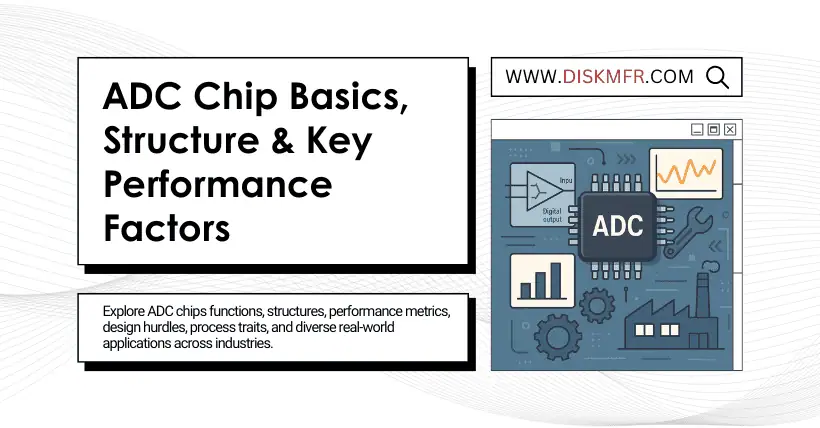01
What is an ADC chip?
ADC stands for Analog to Digital Converter. Its function is to convert continuously varying analog signals from the real world (such as temperature, voltage, sound, light, etc.) into discrete digital signals (like binary code 010101) that computers or digital chips can understand.
You can think of it like this:
The real world speaks “human language” (analog signals),
Digital chips only understand “code” (digital signals),
And the ADC is the “translator” between these two worlds.
02
Why is the ADC chip important?
Almost all physical signals around us are analog, such as ECG signals, sound captured by microphones, or pressure and temperature read by sensors. Yet we want to process, calculate, analyze, and store these signals using digital systems like MCUs, DSPs, or FPGAs. The ADC is a crucial link in this chain—without it, a digital system is like a deaf person who can’t hear anything.
Its importance boils down to two key points:
- Interface bridge: It connects the analog world and the digital world.
- Data starting point: It is the first link in the digital signal processing chain, determining how clearly and how promptly the backend system can “see” and respond.
03
Core principle of ADC: How is analog translated to digital?
Analog-to-digital conversion essentially maps a continuous analog voltage to a discrete digital code.
The ADC’s working process includes three steps:
- Sampling
Captures the analog signal at fixed time intervals using a defined frequency, known as the “sampling rate” (like a camera shutter grabbing a frame each time). - Hold
Holds the signal steady right after sampling so the following circuits can process it without fluctuations. - Quantization and Encoding
Maps the voltage value to a specific binary code. For example, 3.1V might be represented as “101011”.
⚠️ Note: This process inevitably introduces some accuracy loss—this is called “quantization error.”
04
Common types of ADC architectures
There are many kinds of ADCs, each suited to different scenarios and precision requirements. Below are the most commonly used ones in engineering:
SAR (Successive Approximation Register)
Features: Medium speed, medium-high precision, low power consumption.
Principle: Compares the input signal bit by bit with internally generated voltages from a DAC, gradually approaching the real value.
Applications: Integrated into MCUs, industrial instruments, meters, audio control, etc.
Sigma-Delta (Σ-Δ ADC)
Features: High precision, low speed, strong noise resistance.
Principle: Oversampling + noise shaping + digital filtering.
Applications: Audio processing, medical instruments (e.g. ECG), precision measurement.
Flash ADC
Features: Extremely high speed and bandwidth, high power consumption.
Principle: Uses many comparators to perform simultaneous parallel comparisons for near-instant conversion.
Applications: High-frequency communication, radar systems, high-speed video capture.
Pipeline ADC
Features: Medium to high speed, medium precision.
Principle: Breaks the conversion task into multiple stages (pipeline), each handling part of the bits.
Applications: Communication base stations, high-speed data acquisition cards, imaging systems.
05
Key performance indicators: How to evaluate an ADC’s quality?
- Resolution
Unit: bits
Indicates how many distinct voltage levels can be identified. For example, a 12-bit ADC has 2¹² = 4096 levels. - Sampling rate
Unit: SPS (Samples per Second)
Indicates how many samples can be captured per second. High-speed systems like communications and video require high rates. - Signal-to-Noise Ratio (SNR)
Measures how much noise interferes with the conversion. The higher the SNR, the cleaner the signal. - Total Harmonic Distortion plus Noise (THD+N)
Measures the fidelity of the ADC to the input signal. - Effective Number of Bits (ENOB)
The actual usable resolution after accounting for noise and errors, usually lower than theoretical resolution. - Power consumption
Crucial for portable devices. - Input voltage range, reference voltage, interface types (SPI/I²C/parallel), etc.
06
ADC chip manufacturing process and packaging features
Analog signals are highly sensitive to noise, power interference, and circuit matching, so ADCs tend to use mature and stable process nodes like 0.18μm, 0.13μm, or even older 0.35μm technologies, rather than chasing cutting-edge processes.
Some high-performance ADCs use 28nm CMOS with mixed-signal design, depending on application needs.
In terms of packaging, traditional small packages like QFN, TSSOP, and DIP are commonly used. High-end ADCs may use BGA packaging to enhance performance.
07
Engineering challenges in ADC chip design
- Difficult noise control
The analog section is extremely sensitive to power, layout, and electromagnetic interference, requiring strict design. - Trade-off between power consumption and precision
Higher precision typically requires more circuitry and higher power. Designers must balance specs and battery life. - Clock jitter significantly affects high-speed ADCs
- High testing costs
Especially for high-resolution ADCs, testing needs extremely clean environments and expensive equipment. - Heavy reliance on analog design experience
Many design details cannot be automated by EDA tools and require experienced engineers to fine-tune parameters and match components.
08
Typical application areas for ADC chips
| Application Area | Use Case |
|---|
| Consumer Electronics | Audio capture in mobile phones, capacitive touchscreen, sensor interface |
| Industrial Control | PLC collecting temperature, voltage, current, and pressure signals for control systems |
| Medical Equipment | ECG and EEG acquisition systems requiring extremely high precision and low noise |
| Communication Systems | RF signal acquisition in base stations for signal processing, requiring high speed and precision |
| Automotive Electronics | Signal processing in sensor systems such as radar, cameras, and TPMS |
| Aerospace | High-reliability analog acquisition systems for telemetry and monitoring |
09
Future development trends
- Integration into SoCs
More ADCs are being integrated into MCUs, FPGAs, DSPs, etc. - Low-power optimization
Continuous optimization toward sub-milliwatt power levels for IoT and wearables. - Balance of high speed and high precision
New architectures like hybrid SAR-Flash are emerging to meet both bandwidth and precision needs. - Intelligent ADC development
Incorporating basic processing units (e.g., filters, triggers) to perform simple front-end processing and reduce backend load.
10
Conclusion
The ADC chip is the bridge between the real and digital worlds and is essential in nearly all electronic systems. While it may not be as glamorous as CPUs or GPUs, its stability and accuracy directly affect the quality of system data. ADC engineering challenges revolve around analog design experience, noise control, and system integration complexity, which is why it often takes a skilled designer ten years to master this field.

Disclaimer:
- This channel does not make any representations or warranties regarding the availability, accuracy, timeliness, effectiveness, or completeness of any information posted. It hereby disclaims any liability or consequences arising from the use of the information.
- This channel is non-commercial and non-profit. The re-posted content does not signify endorsement of its views or responsibility for its authenticity. It does not intend to constitute any other guidance. This channel is not liable for any inaccuracies or errors in the re-posted or published information, directly or indirectly.
- Some data, materials, text, images, etc., used in this channel are sourced from the internet, and all reposts are duly credited to their sources. If you discover any work that infringes on your intellectual property rights or personal legal interests, please contact us, and we will promptly modify or remove it.








